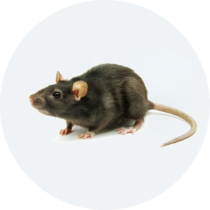Rats

There are two common species of rats
- The Roof rats (Rattus Rattus)
- Norway rats (Rattus norvegicus)
Roof rats are very agile climbers and usually live and nest above ground in shrubs, trees, and dense vegetation such as ivy. In buildings, they are most often found in enclosed or elevated spaces in attics, walls, false ceilings, and cabinets. The roof rat has a more limited geographical range than the Norway rat, preferring ocean-influenced, warmer climates. In areas where the roof rat occurs, the Norway rat may also be present.
Norway Rats are stocky burrowing rodents that are larger than roof rats. Norway rats invade buildings; they usually remain in the basement or ground floor. Generally it is founds at lower elevations but may occur wherever people live.
Rats consume and contaminate foodstuffs and animal feed. They also damage containers and packaging materials in which foods and feed are stored. They cause problems by gnawing on electrical wires and wooden structures (doors, ledges, in corners, and in wall material) and tearing up insulation in walls and ceilings for nesting. Among the diseases rats may transmit to humans or livestock are murine typhus, leptospirosis, trichinosis, salmonellosis (food poisoning), and ratbite fever. Plague is a disease that can be carried by roof and Norway rats.


